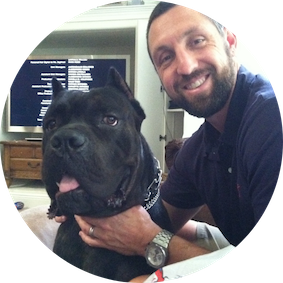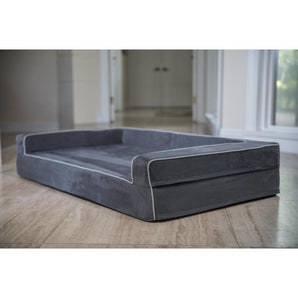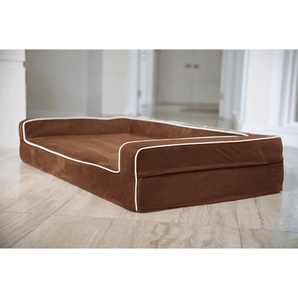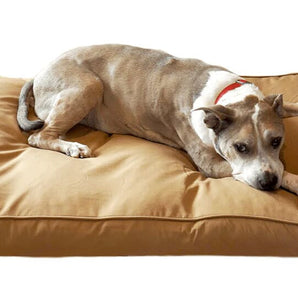Just like many humans experience fear and anxiety, our furry companions also can undergo these symptoms from time to time. Do not worry if you think your pup may be facing these emotions, as fear and anxiety are fairly common in dogs. We understand how frustrating and difficult it can be to try to identify the source of what is making your dog scared or anxious, on top of finding the best and most effective ways to treat it. It is important to fully understand the causes and symptoms of anxiety in dogs before looking for treatments, which is why we have highlighted the full process below.

How to Tell If Your Dog Has Fear and Anxiety
Though it is normal for every dog to be afraid at one point or another in its life, a dog’s fear response can sometimes lead to dangerous behaviors and unhealthy lifestyles. Dogs can become scared when they perceive a person or situation that presents any type of threat, with their nervous system readying their body with the freeze, fight or flight syndrome. Some dogs’ fears may develop into phobias, which is most commonly associated with loud noises, due to a traumatic experience or bad memory. Anxiety, on the other hand, is the anticipation of potential dangers or threats. Separation anxiety is the most common type of anxiety in dogs, which can cause them to defecate indoors, bark, cry, pant or pace. While the range of symptoms can vary between dogs, there are a number of other indications to look for that will help tell if your dog has fear and anxiety. These signs include trembling, tucking their tail between their legs or hiding under furniture. It is also important to note that some dog breeds are more susceptible to anxiety than others. Breeds that have high levels of intense fear include Bernese Mountain dogs, Dalmatians, German Shorthaired Pointers, Great Pyrenees, Siberian Huskies and Standard Poodles among others.
Causes of Fear and Anxiety Within Your Dog
While there can be many contributing factors that cause your dog to become scared or anxious, the three most frequent causes are separation anxiety, loud noises such as thunderstorms or fireworks, and stressful social encounters with other dogs or humans. Dogs are most likely to develop phobias between the ages of one and three, most commonly caused by owners abandoning them or abusing them. During the puppy stage, life can quickly become scary for young dogs if they are stripped of valuable social and environmental experiences early on, making them unsure how to interact and behave around other animals and humans in the future. Medical issues can also cause anxiety in dogs. More specifically, dogs who have encephalitis, hypothyroidism and thyrotoxicosis may be more prone to anxiety. It is important to seek medical attention from a veterinarian while attempting to diagnose your dog’s fear and anxiety. This will allow your vet to confirm or reject any underlying medical conditions that could be causing the behavior.
Treating Dogs Who Have High Fear and Anxiety
If your veterinarian has ruled out any medical issues as the cause of your dog’s abnormal behavior and confirmed the diagnosis as fear or anxiety, there are several different treatments that will help your dog become calmer and more relaxed. In the short term, your vet could prescribe a prescription medication for your dog. Other short-term options that do not require a prescription but have similar benefits can include calm anxiety chews, soft chews that are infused with hemp and other specifically formulated ingredients that are ideal for dogs with separation anxiety, mild aggression, and fear among other anxiety issues. Long-term remedies for fear and anxiety can include thorough training and a more active lifestyle. While dogs can be trained to learn how to sit and shake, they can also be deconditioned to unlearn causes of anxiety. This process can be done through desensitization and counter-conditioning. Desensitization is categorized as repeated and controlled exposure to the factor that causes anxiety while counter-conditioning represents when a dog is trained to perform a positive act rather than an act associated with anxiety and fear. Learning to recognize what gives your dog anxiety or makes it scared is an essential step to preventing an oncoming anxiety attack.
Supervising Dogs Who Have High Fear and Anxiety
Once a dog has been diagnosed and begun some form of treatment, it is important to monitor their behavior. Your veterinarian may require periodic visits to conduct blood tests and make sure your dog has been handling the medication well. If your dog is not responding well to its prescribed medication it may be recommended that you search for alternative treatments to help prevent the increase of anxiety and fear your dog may be experiencing. Training your dog through desensitization and counter-conditioning will be an ongoing process but is vital for them to reach a point where they are calm and relaxed around various people and animals in different environments. Lastly, it is paramount that you create or modify your home environment to eliminate as many stressors for your dog as possible. Providing them with a safe-space at home will allow them to relax in an open area and avoid any factors that could trigger fear or anxiety. Orthopedic beds are great options to help reduce stress and anxiety in your dog as they are not only beneficial for your dog's body and overall health but also provide a high level of comfort.
Do not waste any more time stressing out about your dog’s fears and anxieties. With the right approach, you can identify behaviors that may be associated with anxiety, understand what is causing their unnatural behavior, what the right treatments are and how monitor it moving forward. Be sure to meet with your veterinarian so they can properly diagnose your dog and provide you helpful steps moving forward. Ultimately, it is up to you to help make a change in your dog’s behavior. Be mindful of what makes them uneasy and what makes them comfortable. By being proactive and taking the right steps, your dog will be in a clam and relaxing state in no time, making for a healthier and enjoyable household.




